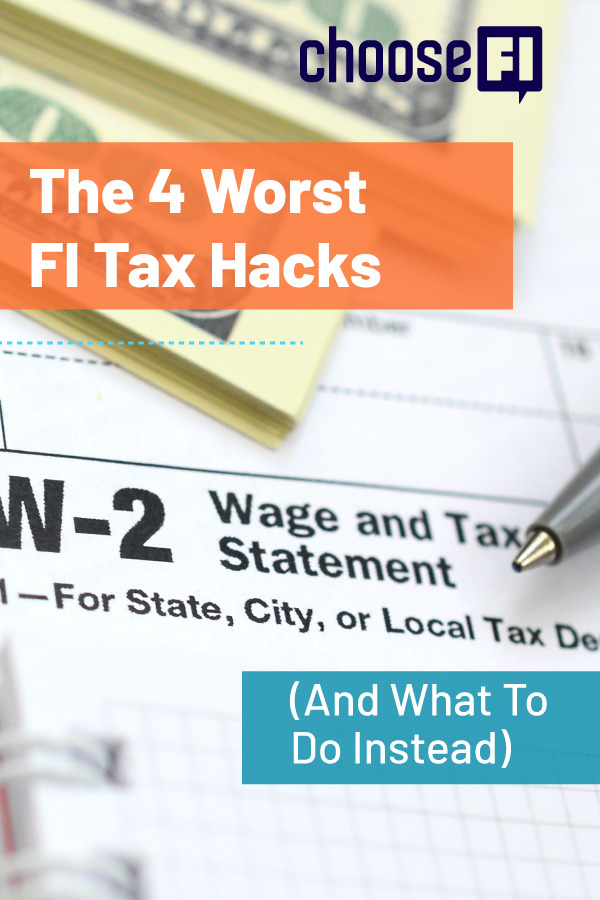This is a guest post from Sean Mullaney. As always, the below commentary is general and educational in nature and does not constitute tax, investment, legal, or financial advice with respect to any particular taxpayer.
There are many great tax ideas in the FI community. I believe some of them are fraught with danger if not properly applied and understood. Here are what I call the four worst FI tax hacks, and what you should do instead.
Roth IRAs For Kids
Wait a minute! I thought you like Roth IRAs for kids. What gives?
What gives is when the money comes out of the Roth IRA. Depending on how and when your child uses the Roth IRA, the idea can be a big winner or a big loser.
The Good: Your child works for your small business and thus your child’s Roth IRA is funded while they are young. Your child leaves the money alone and does not withdraw it for many years (in their 50s, 60s, 70s, 80s, or later) and never pays tax on the money contributed to the Roth IRA and its growth. Even better, money inside your child’s Roth IRA is not considered an asset for FAFSA purposes, so it does not increase your family’s “expected family contribution” (“EFC”) towards their college tuition. You’ll see why I bolded “inside” in a moment.
The Bad: Your child uses their Roth IRA money to pay for their own college. This is a bad idea for two reasons. First, the benefit of the Roth IRA is years of tax-free growth. Why blow what could be decades of additional tax-free growth by withdrawing the money to pay for college in their late teens or early twenties? The opportunity cost of doing so is tremendous.
Second, there is a detrimental FAFSA impact from withdrawing money from your child’s Roth IRA during their college years. Any money withdrawn, including a simple non-taxable return of the contributions made to the Roth IRA, counts as income, up to 50 percent of which goes into the EFC. This can be an up-to 50 percent tax on Roth IRA withdrawals! Ouch!!! Your child’s money should stay inside the Roth IRA during college to protect your child’s FAFSA.
Check out what Sean else has to say about Roth IRAs for kids here.
Tax Loss Harvesting
Tax-loss harvesting is a great tactic. It is a horrible goal. Let me explain.
Is it great to realize some losses at year-end and take a $3,000 loss on your tax return? Sure is. But remember, your goal is some form of Financial Independence. It is not to take a $3,000 loss on a tax return.
This means you should structure your portfolio for total return, and in many cases that means investing (in both taxable and retirement accounts) in some combination of low-cost stock and bond based index mutual funds and ETFs. It does not mean investing in (through a robo-advisor or otherwise) dozens of individual stocks with the hope that some stocks will have losses late in the year.
Remember, you will achieve Financial Independence one day because of total return, not because you realized a $3,000 capital loss every year on your tax return.
A tax hack that hopes for a loss is a bad idea. A much better idea is investing for total return, and in those years where your investments have a loss, pull the trigger and do some tax-loss harvesting.
Here’s Sean’s article on Tax Loss Harvesting over at The FI Tax Guy.
The Solo 401(k) Trap
You’re self-employed. Or you have a side hustle. You find plenty of articles extolling the virtues of the Solo 401(k), so you set up a plan. What could go wrong?
Well, perhaps you aren’t getting the deduction you think you are getting.
Picture Mark, a 30-year-old single professional who is doing well in his career. In 2019, he makes $120,000 from his employer and makes $10,000 (after the deduction for half of his self-employment tax) from a side hustle. Taking the standard deduction, his preliminary taxable income is $117,800 ($120,000 plus $10,000 less $12,200). Figuring that he is in the 24% bracket, Mark decides to make a $10,000 traditional deductible contribution to a Solo 401(k) so that he can save $2,400 in federal income taxes.
Did Mark’s plan work? Absolutely not! Instead of saving $2,400 in 2019 federal income taxes, Mark saved only $1,920. Worse, in the future when Mark takes the money out of the Solo 401(k) (through a Roth Conversion or a withdrawal), all $10,000 and the growth will be subject to full ordinary taxation! At a 24% rate, he would have to pay at least $2,400 in ordinary income tax when he takes it out.
Why was Mark wrong? Mark neglected to account for the new Section 199A qualified business income (“QBI”) deduction and thus fell into the Solo 401(k) Trap. By zeroing out his self-employment income of $10,000, Mark cost himself a $2,000 QBI deduction. That’s why his traditional Solo 401(k) saves him only $1,920 in federal income taxes.
What should Mark have done instead? If he made no more than $9,000 in employee contributions to his W-2 employer’s retirement plan, he could have put the $10,000 contribution into a Roth Solo 401(k). Alternatively, he could have made after-tax contributions to the Solo 401(k) as part of a Mega Backdoor Roth IRA strategy. Mark could even simply invest the $10,000 in taxable accounts and/or use part of it to fund a Roth IRA if he hasn’t otherwise done so.
Here’s what else Sean has to say about the Solo 401(k) trap.
Real Estate In Retirement Accounts
You decide to invest in real estate. You’ve read that it is great to hold real estate in a tax-advantaged account. Is that really true? Let’s look at an example.
Beth decides to invest in an 8th-floor condo that costs $250,000. She estimates that she can rent it out for $2,500 per month. She will pay $100,000 down and borrow $150,000 at 5.5% to finance the purchase. The condo will have $1,250 per month of property taxes, maintenance, HOA fees, and other operating expenses.
If she holds the condo in a taxable account, in the first full year it will produce approximately $32,300 in tax deductions (approximate numbers: depreciation: $9,100, interest: $8,200, operating expenses: $15,000) and $30,000 in gross revenue. Thus, it will produce a taxable loss of approximately $2,300 (which might be useable against other income) even though the property is cash flow positive. Beth has unfettered access to that positive cash flow.
What if the house is owned in a retirement account? Let’s consider traditional retirement accounts. Every dollar Beth withdraws from a traditional retirement will fully taxable (i.e., Beth will get no benefit from the depreciation and other tax deductions associated with the property.) If Beth attempts to access the money before age 59½ she will most likely be subject to a 10 percent early withdrawal penalty.
Okay, so a traditional IRA or 401(k) is bad for real estate. But what about a Roth? Surely that’s a great place for Beth to hold real estate, correct? Unfortunately, no. There are several reasons why Beth would not want to hold real estate in a Roth account:
- Beth will need a self-directed Roth IRA or Roth 401(k). Custodian fees for self-directed accounts will be significantly higher than what Beth will find at a low-cost financial institution.
- Beth loses the ability to claim tax losses with respect to her rental real estate.
- Beth faces some limitations on the ability to remove cash from the Roth IRA without a penalty and income tax before age 59½.
- Beth is subject to a whole host of restrictive rules, including the inability to personally do any repairs or maintenance work on the rental real estate.
- Beth’s heirs lose the valuable tax step-up in basis in the rental real estate.
- Beth’s heirs will incur the cost of obtaining an annual valuation in order to determine their required minimum distributions (“RMDs”) from the Roth account (Beth will too if the real estate is in a Roth 401(k).)
- If Beth’s rental real estate is profitable and held in a Roth IRA, the Roth IRA will be subject to the unrelated business income tax to the extent the real estate is leveraged.
Note that many of these reasons also apply to traditional retirement accounts as well.
Generally speaking, it is best to hold financial assets (stocks, bonds, mutual funds, and ETFs) in traditional and Roth retirement accounts and hold real estate in taxable accounts. Financial assets benefit from the tremendous competition in the financial services industry (which is reducing investing costs) and the tax-advantaged nature of traditional and Roth IRAs and 401(k)s. Real estate benefits from depreciation and the step-up in tax basis available in taxable accounts, and is subject to significantly increased fees and restrictions in retirement accounts.
Here’s what else Sean has to say about Real Estate Losses.
Conclusion
I’m not aware that anyone has ever been buried going down the rabbit hole of FI tax hacks, but before implementing a FI tax hack in your own life, you should carefully assess whether that particular hack will help optimize your tax situation. In some cases, it will be advisable to consult with a tax professional before implementing a tax planning strategy.
Related Articles
Sean Mullaney is a financial planner and the President of Mullaney Financial & Tax, Inc., a California accountancy corporation and registered investment advisor. This post does not constitute financial, investment, tax, or legal advice and is for educational and entertainment purposes only.




